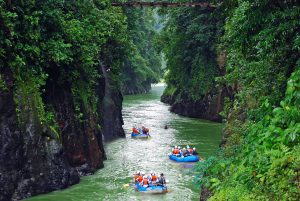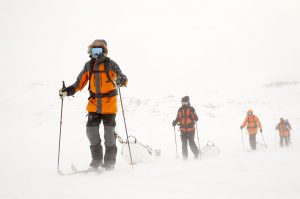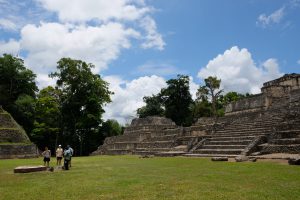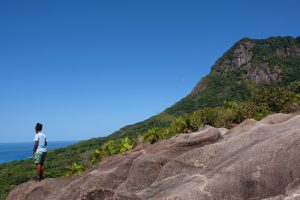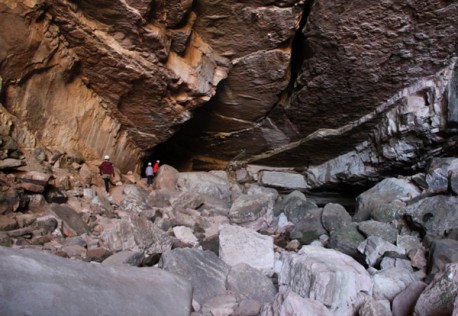
Entering La Caverna de Umajalanta. Image: Thomas Duggan
Amelia Duggan explores the cave systems of Torotoro National Park
View online at countrybycountry.com
I’m sitting shoulder to shoulder with my brother Tom on a sun-beaten hillside, both of us eating sandwiches — much as we used to do on family picnics as kids. Except we’re not in Richmond Park, we’re in central Bolivia. And these sandwiches contain llama steak. And we’ve just passed the morning examining ancient painted hieroglyphs and tripping over diplodocus footprints in a prehistoric riverbed.
The scenery is spectacular. From where we’re perched, several thousand metres above sea level in the Andean Cordillera, a dramatic, boulder-strewn valley unfurls before us; the land rising in the distance to form russet canyon crags and, on the horizon, jagged, snow-tipped mountains. But the view only holds half my attention, and I can tell that Tom is preoccupied too: we’re about to go caving for the first time in La Caverna de Umajalanta — a massive subterranean network of narrow passages stretching nearly three miles into the belly of Torotoro National Park.
Our guide, a local teenager called Elias, calls us back to the 4WD, where he’s reassuring my friend Ellie that very few people become wedged in the underground tunnels, and fewer still get lost. He laughs at our nervous expressions, revealing a warm, crooked smile full of pointed incisors and one square front tooth, and grandly intones something in Spanish. I make a note and translate it later. It’s an old Andean proverb: ‘If you’re going to die, you’ll die in the dark, even if you’ve been in the candle business.’
A short, bumpy drive and a downhill hike later, and we’re standing at the dripping entrance to the caves, clutching hard hats and headlamps. The floor is pitted and steep, and as we edge into the darkness I hear the beating of wings above me: bats.
Ellie’s gone, scampering back towards the sunshine as fast as the slippery rocks will let her. The rest of us press on through the narrowing cavern, scooting, scrambling and eventually belly-shuffling through the slimy arteries of the land. After some time, we reach a ledge and Elias shows us how to abseil over it into the pitch black using a coarse rope that’s been nailed into the rock. He expertly dismounts on a dry ledge several metres below. Tom manages it but I end up landing waist deep in a cold pool with an indecorous splash.
Scanning my dim torch beam around me, I see we’ve entered a grotto full of pale, glossy stalagmites and stalactites — some as stocky as lampposts, some as slender as icicles — climbing up from the rocks and trailing down from the vaulted ceiling. We wend our way along small paths around the ancient calcified lattices, Elias pointing out what each larger formation reminds him of. “A Christmas tree,” he says solemnly, pointing to a completely amorphous mound.
We settle down on a sandy swathe of ground and turn our torches off. Elias tells us how, as part of his tour guide training, he had to come down here alone and sit in the complete darkness until he was no longer afraid of the unseen. “In the dark you must battle your mind,” he says.
We sit in silence, unable to see our hands in front of our faces, and I try not to think about bats and spiders. To distract myself I imagine this cave being formed by a huge tectonic surge hundreds of millions of years ago, a sandy sea bed hurled upwards into volcanic rock to create the powdery pocket in which I am sitting.
Tom’s torch flickers back to life and the spell is broken.
We follow Elias’s nimble steps. “One last stop”, he says. We emerge from the most claustrophobic tunnel yet into a cavern that is as large as a cathedral, sheltering a dark, placid lake. Descending to the water’s edge we see milky-coloured fish flitting lazily in the shallows. Under the light of our torches their scales look translucent and jelly-like. They’re eyeless and repulsive; Elias tells us they are blind.
That evening, back at the sleepy, whitewashed village of Torotoro, Ellie, Tom and I are sitting on a wall outside a homely diner watching black-haired children chase each other in the dusty street. The dying light is painting the scene with warm yellow hues, and soon it will be dark. There won’t be any streetlights to guide us back to the hostel but after today, that doesn’t seem so scary.





